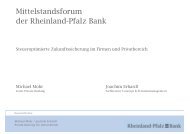Annual Report 2006 - Rheinland Pfalz Bank
Annual Report 2006 - Rheinland Pfalz Bank
Annual Report 2006 - Rheinland Pfalz Bank
Create successful ePaper yourself
Turn your PDF publications into a flip-book with our unique Google optimized e-Paper software.
22 LRP <strong>2006</strong><br />
18,000<br />
16,000<br />
14,000<br />
12,000<br />
10,000<br />
8,000<br />
6,000<br />
4,000<br />
2,000<br />
0<br />
A.0 A.1 A.2 A.3 A.4 A.5 B.1 B.2 B.3 B.4 B.5 C.1 C.2 C.3 C.4 C.5 D.1 D.2 D.3 D.4 D.5<br />
Distribution of individual risks into rating categories (LRP Group)<br />
Commitments in 1 billion (total: 1 84.2 billion)<br />
The classification of individual borrowers, groups or,<br />
possibly, transactions is performed using LRP’s internal<br />
rating systems. Ratings are determined on the basis<br />
of a number of historical and forward-looking factors.<br />
Apart from the probabilities of default, expected loss<br />
ratios and recovery ratios are derived from the rating<br />
systems with the help of additional information on the<br />
structure of the exposure.<br />
The weighting of the individual rating factors in the rating<br />
process is based on historical data and expert<br />
knowledge. For all internal rating procedures we use<br />
the same master scale with 21 non-default classes and<br />
one default class which distinguishes between different<br />
default reasons. The definitions of default and recovery<br />
of debtors have been harmonized with those of<br />
LBBW; a process ensuring an efficient Group-wide exchange<br />
of information between LRP and LBBW, especially<br />
with regard to default information and a harmonized<br />
risk management approach, has been implemented.<br />
Internal ratings serve to support decisions on the extension<br />
of loans and serve as the basis for numerous<br />
controlling tools. By taking exposure-specific components<br />
into account in the rating process, we pursue<br />
several objectives: a rating-oriented competence hierarchy,<br />
a consistent basis for the definition of upper<br />
credit limits, a pricing policy geared to collateral and<br />
portfolio risks as well as transaction-specific pre/postcalculation.<br />
Moreover, the ratings serve as yardsticks<br />
for the specific processes in intensive monitoring, reorganization<br />
and liquidation cases.<br />
Limits for individual customers, groups and country<br />
limits are dependent on the respective ratings. The use<br />
of these limits as well as the use of the individual lines<br />
is determined automatically on a daily basis by aggregating<br />
the individual exposures from the different operational<br />
systems.<br />
Risk classification of individual borrowers is reviewed<br />
at least once per year and updated whenever there are<br />
indications of material changes at the borrower or in<br />
his immediate environment which affect the borrower’s<br />
credit standing. Internal Auditing regularly reviews<br />
the proper allocation and monitoring of ratings.<br />
Any change in the rating will have a direct effect on the<br />
volume of new business as well as on margins.<br />
All essential rating information taken into account in<br />
the rating algorithm is electronically stored so that we<br />
can draw on a sufficiently long historical observation<br />
period in case of future modifications to the rating procedures.<br />
We pool our data with other banks with a view<br />
to putting the ongoing validation and updating of the<br />
rating procedures on a broader basis.
















